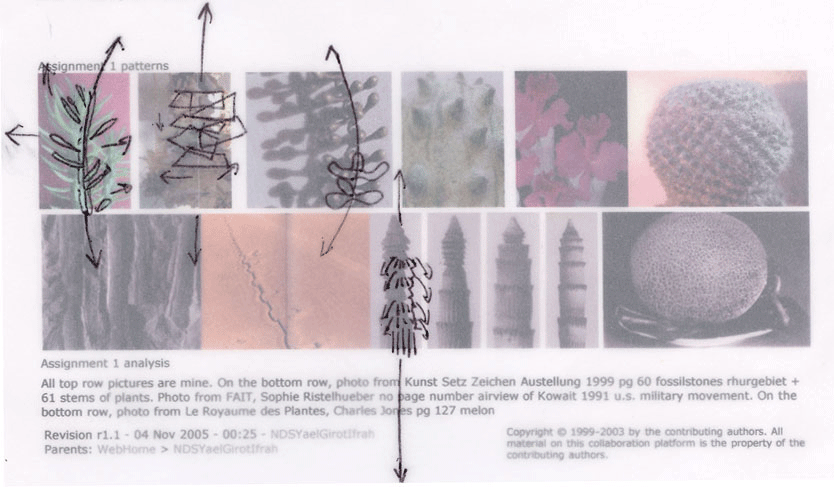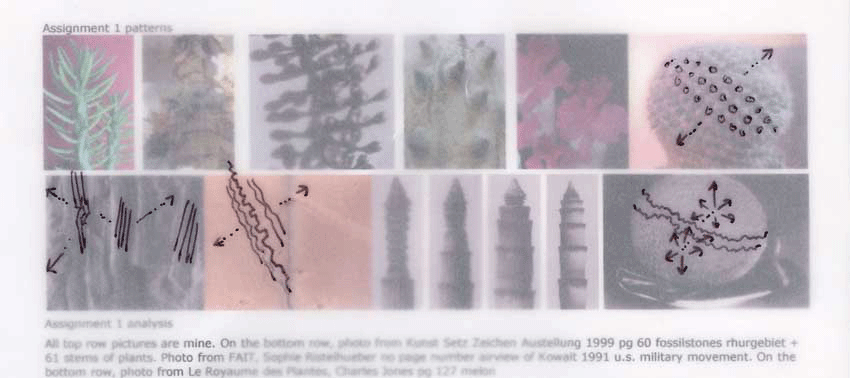 |
|
||||||||||

| MAS ETH ARCH/CAAD - 2005/06 - STUDENT PAGES Master of Advanced Studies in Architecture, Specialization in Computer Aided Architectural Design | 065-0005/6 Supervision: Prof. Dr. Ludger Hovestadt, Philipp Schaerer Chair of CAAD, ETH Zurich pattern| pattern rules | script + screen shots | 3D + 2D printer |
 All top row pictures are mine. On the bottom row, photo from Kunst Setz Zeichen Austellung 1999 pg 60 fossilstones rhurgebiet + 61 stems of plants. Photo from FAIT, Sophie Ristelhueber no page number airview of Kowait 1991 u.s. military movement. On the bottom row, photo from Le Royaume des Plantes, Charles Jones pg 127 melon
All top row pictures are mine. On the bottom row, photo from Kunst Setz Zeichen Austellung 1999 pg 60 fossilstones rhurgebiet + 61 stems of plants. Photo from FAIT, Sophie Ristelhueber no page number airview of Kowait 1991 u.s. military movement. On the bottom row, photo from Le Royaume des Plantes, Charles Jones pg 127 melonpattern analysis   A picture is worth a thousands words.... perhaps a mathematical equation as well.... I could not say. In the two diagrams I have showed what appears to me the structural similarities among the patterns.
A picture is worth a thousands words.... perhaps a mathematical equation as well.... I could not say. In the two diagrams I have showed what appears to me the structural similarities among the patterns. First Keyword: Stemming from a central axis: The first set has a center core axis (that can expand in diameter) and grow out of the images. From the center core, there are objects, some volumetric, some planar, that go from the stem in differing directions. They each rotate around the core axis. In all of these examples, there is an attention to the textures and skin characteristics (shine, smoothness, roughness) of these elements and how the forms can inform the direction in which they are pulling. I honestly haven't made my choice yet. Second Keyword: Repetition of receding elements: The second set have all the*line* as core element. This line varies in each exempl in quality of direction and quality of line. One line is even made up of circular shapes. In all exemples are the line weight and capacity to either be above (extrude) or below (imprinted) a surface plane. This is very important to the final output of the pattern. Here there is an attention to the repetition of the core line in differing frequency and pressure, that goes away from the core line and recedes towards horizon points. This gives a very important added notion of space among a 2D drawing. Detail Recipe for one pattern: The central character is a string that is taught (pulled by a force downwards and upwards). The string is not thick at all, in fact, it is quite invisible. The secondary characters are planes that intersect in a generally speaking perpendicular manner the central character (the string). They intersect the string, generally in their center. They are like leaves. These planes, although generally perpendicular, can be at small degrees of differing angles ( clockwise and counterclockwise) from an exact perpendicular. There sequences in random. The size of the planes are quite similar, but can also differ slightly in size. Lastly the planes are not perfectly flat, nor are they very thick. They continue the visible length of the central character. Detail Recipe for second pattern: The central character is a deep grooved line that is thick in size and has continous sinous curves. The curves are quite small. The line goes from the middle center bottom towards the left upper corner at a slope. The second character is the plane receiving the line. Its colour is quite luminous, making the groove read even more than normal. The surface of the plane is slighty scratched everywhere. These scratches are the third characters. Theay are not deep grooves like the central character, but much softer. They are generally in the same direction as the central character.
| ||||
This website has been archived and is no longer maintained.
